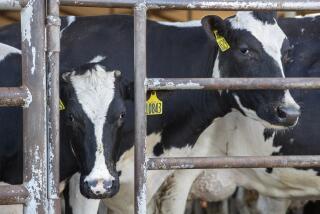FDA Monitoring Helps Keep Plane Food Safe : Airlines: Making sure carriers serve different foods at the proper temperatures is biggest concern of health officials. Flight delays can pose particular problems.
While the flavor of airline food is what interests most travelers, it’s the temperature of meals that concerns the U.S. Food and Drug Administration, which checks the carriers to ensure that food is prepared, transferred, maintained and served at the proper temperature.
How does the FDA monitor food served on airlines? And what action can the consumer take, should he or she think that food on a U.S. carrier has been tainted?
Under the Public Health Service Act, the FDA is responsible for the safety of food served on planes, trains and buses engaged in interstate traffic. (Airlines represent the largest area of FDA responsibility, since air carriers serve the greatest number of meals.) This authority also covers the catering kitchens serving them, as well as flights departing from the United States.
“We inspect flight kitchens twice a year or more at LAX, with the aircraft spot-checked,” said George Gerstenberg, district director of the FDA in Los Angeles. “If there’s a problem, then we schedule more inspections.”
Kitchen inspections review how raw products are stored, refrigeration temperatures, cooking and dishwashing procedures and overall sanitation.
Transfer vehicles that carry food from flight kitchens to the plane are also checked.
“Our biggest problem is having foods kept properly refrigerated when transported to the planes, and we particularly make checks during warmer weather,” Gerstenberg said.
“We have to be careful that airlines don’t cut corners in food operations, but we’ve had very few problems at LAX.”
If everything isn’t done properly, the food can become tainted. The danger zone for bacterial growth in food is from 45 to 140 degrees, according to FDA spokesman Emil Corwin.
Food is prepared and preserved on land, transferred to planes and stored until preparation and service during flight.
The food is taken from the transfer trucks and placed in compartments in the airplane galley. Food to be heated goes into ovens so the warming process can begin immediately, even if the plane is still at the gate. Food to be served cold goes into separate refrigerated compartments.
Generally, protein foods such as fish and poultry must be served hot or cold, depending on the dish, but not at cabin temperature. “If you receive a lukewarm steak, this means it hasn’t been reheated properly, even if you’re the last passenger to be served on a 747,” Gerstenberg said.
Along the same culinary lines, a warm seafood salad is one that hasn’t been maintained at the correct temperature.
Problems sometimes occur when there are flight delays. As a result, meals--as well as passengers--are kept in a holding pattern. The longer the delay, the more chance for bacterial growth.
Long-distance and double-meal boarding can also cause problems. Food that must be preserved for very long flights or for both outbound and return flights must be carefully monitored.
Further, FDA determinations on particular foods are utilized by the flight kitchens, said Michael Kasnia, a spokesman for the In-Flight Food Service Assn., a Louisville, Ky.-based organization of caterers and suppliers serving the airlines.
“The FDA made a determination that using raw shell eggs might pose a salmonella problem, and now our members use pre-pasteurized egg products instead,” Kasnia said.
The FDA has also worked with the IFSA to educate airline and catering firm personnel on all aspects of food preparation and transportation. A training program, developed by the FDA in conjunction with food scientists from Cornell University, is used to educate personnel at flight kitchens.
“We’re currently working with the FDA on a new food-safety quality assurance manual based on hazard analysis that may become a standard for the industry,” Kasnia said. The manual is expected to be out later this year.
The FDA also checks with manufacturers of galley equipment to make sure the units are suited for their purpose. “We look at equipment while it’s still in the design stage, before it gets into the plane,” Gerstenberg said.
While much FDA work is with airlines, the government agency does cover other modes of transportation. To illustrate, the FDA recently took action against Amtrak for a “temperature and sanitation problem,” Gerstenberg said. The train in question was taken out of service and retrofitted.
The FDA will take complaints regarding adverse physical reactions to food and drink served by American carriers aloft as well as on land. Call the FDA at (213) 252-7589, or the Division of Emergency & Epidemiological Operations of the FDA at (301) 443-1240.
More to Read
Inside the business of entertainment
The Wide Shot brings you news, analysis and insights on everything from streaming wars to production — and what it all means for the future.
You may occasionally receive promotional content from the Los Angeles Times.










